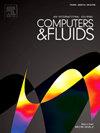长距离冲击驱动物体动力学的非惯性计算框架
IF 2.5
3区 工程技术
Q3 COMPUTER SCIENCE, INTERDISCIPLINARY APPLICATIONS
引用次数: 0
摘要
在动态分离问题领域,由冲击相互作用引发的物体运动是一种常见现象。这对于两级入轨飞行器的安全分离尤为重要,因为在这种情况下,尽管受到冲击波的长距离干扰,运动仍必须保持稳定。这些情况下的流场非常复杂,其特点是高超音速冲击波与运动边界之间的相互作用。由于机体在长距离内的平移和旋转,这导致了严重的不稳定效应。现有的模拟技术无法快速准确地预测这些问题的气动力和热特性,这主要是由于过大的计算域和网格变形的必要性导致了过高的计算要求。本文提出了一种新颖的非变形网格方法来应对这些挑战。其核心理念是将参考框架锚定在运动物体本身,并从非惯性框架的角度来处理问题。这种方法仅通过惯性源项来考虑物体的运动,从而避免了连接流动方程和运动方程通常所需的复杂网格操作。移动冲击边界的设计与选定的冲击捕获方案密切兼容,与直接装配理论冲击关系的传统方法相比,减少了非物理振荡。其他边界条件和求解过程也进行了改进,以专门针对以冲击为主的非稳定流。这些修改大大减轻了计算负担。通过几个测试案例证明了所提方法的有效性。为了展示该方法的实际应用,我们模拟了一个椭圆被入射冲击波从楔形中移开,并覆盖很长一段距离的场景。这些测试证实了该方法在航空航天工程问题中的可行性。本文章由计算机程序翻译,如有差异,请以英文原文为准。
Non-inertial computational framework for long-distance shock-driven object dynamics
In the realm of dynamic separation problems, the motion of a body triggered by shock interactions is a common phenomenon. This is particularly important in terms of the safe separation of two-stage-to-orbit vehicles, where the motion must remain stable despite long-distance disturbances from shock waves. The flow field in these cases is complex, marked by interactions between hypersonic shock waves and a moving boundary. This leads to significant unsteady effects due to the body's translation and rotation over extended distances. Existing simulation techniques fall short in rapidly and accurately predicting the aerodynamic force and thermal properties for these problems, largely due to the overwhelming computational demands that result from oversize computational domains and the necessity of grid deformation. This paper presents a novel non-deforming grid method to address these challenges. The central concept is to anchor the reference frame to the moving object itself and to approach the problem from a non-inertial frame perspective. This accounts for the motion of the object solely via the inertial source term, circumventing the complexities of mesh manipulation typically required to link flow and motion equations. The moving shock boundary is designed to be closely compatible with selected shock-captured schemes, which reduces non-physical oscillations compared to the traditional method of direct assembly with theoretical shock relations. Other boundary conditions and the solution process are also refined to specifically target the unsteady, shock-dominated flow. These modifications significantly alleviate the computational burden. The effectiveness of the proposed method is demonstrated through several test cases. To showcase the method's practical application, a scenario is simulated wherein an ellipse is dislodged from a wedge by an incident shock wave, covering a long distance. These tests confirm the method's feasibility in aerospace engineering problems.
求助全文
通过发布文献求助,成功后即可免费获取论文全文。
去求助
来源期刊

Computers & Fluids
物理-计算机:跨学科应用
CiteScore
5.30
自引率
7.10%
发文量
242
审稿时长
10.8 months
期刊介绍:
Computers & Fluids is multidisciplinary. The term ''fluid'' is interpreted in the broadest sense. Hydro- and aerodynamics, high-speed and physical gas dynamics, turbulence and flow stability, multiphase flow, rheology, tribology and fluid-structure interaction are all of interest, provided that computer technique plays a significant role in the associated studies or design methodology.
 求助内容:
求助内容: 应助结果提醒方式:
应助结果提醒方式:


